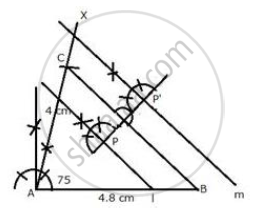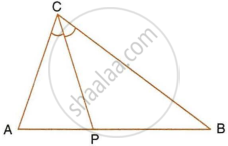Advertisements
Advertisements
प्रश्न
Construct a triangle ABC, having given AB = 4.8 cm, AC = 4 cm, and ∠A = 75°. Find a point P.
- inside the triangle ABC.
- outside the triangle ABC
Equidistant from B and C; and at a distance of 1.2 cm from BC.
उत्तर

Steps of construction:
- Draw a line segment AB = 4.8 cm
- At A, draw a ray AX making an angle of 75°
- Cut off AC = 4 cm from AX
- Join BC.
ABC is the required triangle. - Draw two lines l and m parallel to BC at a distance of 1.2 cm
- Draw the perpendicular bisector of BC which intersects l and m at P and P’
P and P’ are the required points which are inside and outside the given triangle ABC.
APPEARS IN
संबंधित प्रश्न
Given: PQ is perpendicular bisector of side AB of the triangle ABC.

Prove: Q is equidistant from A and B.
Given: CP is bisector of angle C of ΔABC.

Prove: P is equidistant from AC and BC.
Given: AX bisects angle BAC and PQ is perpendicular bisector of AC which meets AX at point Y.

Prove:
- X is equidistant from AB and AC.
- Y is equidistant from A and C.
Construct a triangle ABC in which angle ABC = 75°, AB = 5 cm and BC = 6.4 cm. Draw perpendicular bisector of side BC and also the bisector of angle ACB. If these bisectors intersect each other at point P; prove that P is equidistant from B and C; and also from AC and BC.
Describe the locus of the centre of a given circle which rolls around the outside of a second circle and is always touching it.
Describe the locus of the centres of all circles that are tangent to both the arms of a given angle.
Describe the locus of the mid-points of all chords parallel to a given chord of a circle.
Describe the locus of points within a circle that are equidistant from the end points of a given chord.
